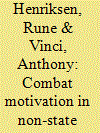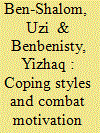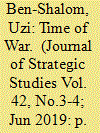|
|
|
Sort Order |
|
|
|
Items / Page
|
|
|
|
|
|
|
| Srl | Item |
| 1 |
ID:
177847


|
|
|
|
|
| Summary/Abstract |
United Nations (UN) peacekeeping operations are among the most effective tools available for the international community to deal with threats to international peace and security. However, such operations have also been presenting significant shortcomings, like below average performances of some peacekeeping units. Against this backdrop, this article discusses the complexities of robust peacekeeping and the problem of military underperformance, intending to ascertain the significance of combat motivation as a contributing factor to the efficiency of UN military components and the effectiveness of robust peacekeeping missions. The results indicate the relevance of combat motivation for UN troops’ better performances. Also, the findings point out the need to enhancing affective aspects in the preparation of the blue helmets, like self-confidence, small units cohesion, leadership, and sense of the cause.
|
|
|
|
|
|
|
|
|
|
|
|
|
|
|
|
| 2 |
ID:
080880


|
|
|
|
|
| Publication |
2008.
|
| Summary/Abstract |
Existing analyses of non-state armed-group combat motivations are inadequate because they essentialize combat motivation, fail to recognize the polymorphous character of non-state warfare, and confound agency and structure by equating individual combatant motivation with the context of the conflict. In order to account for the more dynamic nature of combat motivation in armed groups versus conventional militaries, this article offers a two-dimensional framework for understanding combatant motivation. The first dimension is based on context-specifically, terrorist, insurgent and warlord forms of warfare-and the second on individual motivation-including communitarian, economic, and existential motivations. The article then illustrates the interplay between these two dimensions.
|
|
|
|
|
|
|
|
|
|
|
|
|
|
|
|
| 3 |
ID:
148250


|
|
|
|
|
| Summary/Abstract |
The characteristic challenges of combat lead military personnel to develop adaptive coping styles that are different from coping styles used in routine life. This contention is explored using data collected from Israel Defense Forces conscript and reserve soldiers during intense military operations. The results of this study support this claim, in particular concerning faith. Coping styles were also correlated with combat motivations and measures of positive and negative emotions. It seems that a well-adapted soldier may use unique coping styles that, although perhaps not understood by outsiders, can contribute to his capacity to carry out his undertakings. A better understanding of such a state of mind should prove valuable for military leaders and religious experts.
|
|
|
|
|
|
|
|
|
|
|
|
|
|
|
|
| 4 |
ID:
057458


|
|
|
| 5 |
ID:
164291


|
|
|
|
|
| Summary/Abstract |
This paper explores the construction of combat motivation in the Israel Defense Forces (IDF), arguing that although Israeli society at large is in a ‘Post Heroic’ era, the ‘Heroic Spirit’ is revealed during emergencies. A total of 1535 questionnaires were administered among combat soldiers during large-scale operations fought during national emergency and during small-scale routine operations. The results reveal differences in the construction of combat motivation typical for emergency vs. routine, as well as for reserves vs. regular units. These results indicate that the Post Heroic era is a condition that could be shifted according to cultural, organisational and individual determinants. This paper discusses the roots of these constructions and their implications on the theory of combat motivation and combat experience.
|
|
|
|
|
|
|
|
|
|
|
|
|
|
|
|
| 6 |
ID:
094139


|
|
|
|
|
| Publication |
2010.
|
| Summary/Abstract |
Mandates for UN peacekeeping operations in Africa have become more robust since the delivery of the Brahimi Report in 2000. Contrary to before, soldiers are now unmistakably expected to use force to protect local civilians in a number of UN peacekeeping missions in Africa. While this expectation of force may be celebrated, the question rises whether peacekeeping soldiers can meet the expectation. Are they ready to kill and risk their lives to protect local civilians? This question is especially pertinent to Western armed forces, which have contributed little to post-millennium UN peace operations in Africa but are explicitly called upon by the UN administration to contribute to the robust peacekeeping missions. This article discusses the question of moral and psychological preparedness in light of the possible tension between the nationalist orientation in Western armed forces and the cosmopolitan demands of UN peacekeeping operations in Africa.
|
|
|
|
|
|
|
|
|
|
|
|
|
|
|
|
| 7 |
ID:
167460


|
|
|
|
|
| Summary/Abstract |
The current combat motivation model based on primary group thesis assumes that the main force behind motivation is peer-bonding or otherwise known as unit cohesion. Cohesion is perceived as an all-encompassing factor that leads to satisfactory (or unsatisfactory in lack thereof) military effectiveness and performance in conflict environments. However, the article identifies three main problems with this perspective: 1. mono-dimensional view of motivation; 2. motivation based on heteronomy, and 3. self-reporting bias. The current model does not consider motivation as a separate entity from cohesion; it does not place motivation as fundamental human value; lastly, it takes motivation as granted by-product of socialization. The article proposes a new combat motivation model based on The Self-Determination Theory. The theory maintains that human motivation requires satisfaction of three psychological needs of competence, relatedness, and autonomy. The degree of satisfaction of those three needs leads to different types of regulated motivations – a continuum from intrinsic to extrinsic – each of which has specifiable consequences for learning, performance, and well-being of an individual.
|
|
|
|
|
|
|
|
|
|
|
|
|
|
|
|
|
|
|
|
|